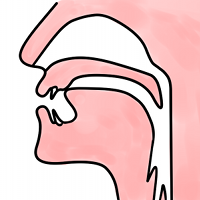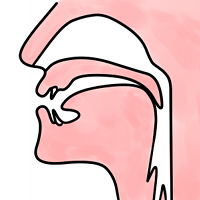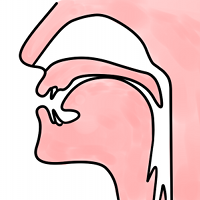ñ (eñe)
The letter ñ is commonly described as the n in “onion” or in “canyon”. Unfortunately, that’s only partially true. It depends on exactly how you pronounce those words. Following that advice, chances are you end up pronouncing Begoña (female proper name) as begonia (“begonia”), with unpredictable consequences.
In a way, the /ñ/ sound is just another “variety” of /n/. If you speak English, you already know how to pronounce two varieties:
- The n in sin: the tip of the tongue against the alveolar ridge (just behind the upper front teeth).
- The n in sing: the back of the tongue against the soft palate (the back of the roof of the mouth).
The /ñ/ sound just sits in the middle. The three of them are nasal consonants. The only difference is the position of the tongue:
- The ñ in señor: the middle of the tongue against the hard palate (the middle of the roof of the mouth).



EXERCISE
Just try to pronounce the word “now” with the tip of the tongue resting behind the lower front teeth (so that the middle of the tongue touches the hard palate). Keep your tongue far apart from your upper front teeth. You’ll find yourself pronouncing the word “ñow” (whatever that means).
ll (elle)
The letter ll has two alternative sounds, none of them exists in English:
- Traditionally, it is pronounced as a “palatal l”, so to speak. More on that in a minute.
- However, that palatal sound is being gradually replaced by the consonantal sound of the Spanish letter y (see later). That means that baya (“berry”) would sound exactly like valla (“fence”).
Yeísmo
That phenomenon (the tradicional /ll/ sound being replaced by the consonantal /y/) is called, in Spanish, yeísmo. It is now so widespread that it is officially accepted as the norm.
Places where the /ll/ sound survives include: Bolivia, Paraguay, areas of the rest of South American countries (except Uruguay) and some areas of Spain.
How to pronounce the /ll/ (“palatal l”) sound
You know now that the /ñ/ sound is just a “palatal” /n/ sound, right?. By the same token, the /ll/ sound is simply a “palatal” /l/.
Both /l/ and /ll/ are lateral consonants, that is, they are pronounced by directing the airstream over the sides of the tongue. The difference is that the /ll/ needs the middle of the tongue against the hard palate instead of the tip against the alveolar ridge.
| Alveolar | Palatal | |
|---|---|---|
| Nasal | /n/ | /ñ/ |
| Lateral | /l/ | /ll/ |
EXERCISE
So, try it: pronounce the word “low” with the tip of the tongue resting behind the lower front teeth. Practice it and you’ll be soon pronouncing perfectly: “llow”, “llow”, “llow” (you are doing this privately, right?).